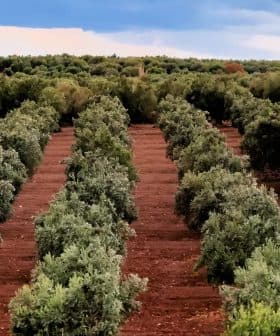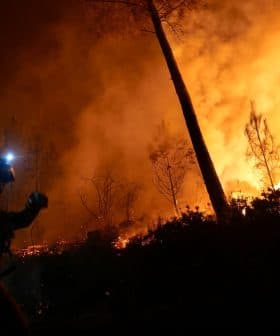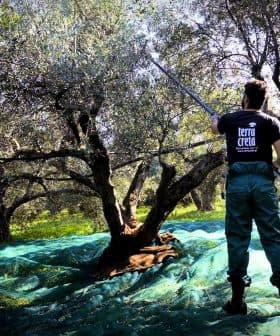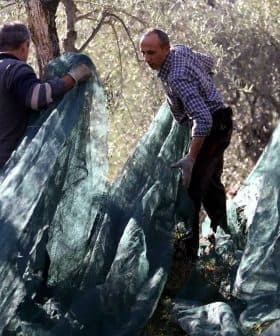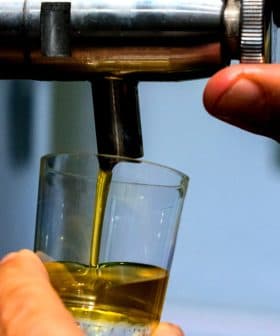Climate Extremes, Economic Pressures Dampen 2023 Harvest, Survey Finds
Olive oil producers gave the 2023 harvest a dismal rating in terms of yields and quality.
 (Photo: George Colletti, Fratelli Colletti)
(Photo: George Colletti, Fratelli Colletti)  9.1K reads
9.1K readsThe 2023 olive oil harvest received the lowest rating since 2018, with farmers and millers most disappointed with their yield and production quality. Climate change, lack of consumer knowledge, and labor difficulties were cited as the biggest concerns affecting the harvest, with producers calling for standards enforcement, increased government support, and global marketing campaigns to promote olive oil consumption.
Farmers and millers across the olive oil-producing world are getting over one of the toughest harvests in recent memory.
Poor weather conditions and frosts at the end of March did a lot of damage to the olive flowers and following production. For some elderly farmers, there has never been such a poor harvest since 1990.
In our annual survey, sent to 4,487 producers in 34 countries, respondents gave the 2023 harvest an overall rating of 51 out of 100, the lowest score since 2018.
Farmers and millers were most disappointed with their yield, rating it just 46 out of 100 – but also gave their judgment of the quality of their production the lowest score (72/100) since the survey began.
The despondency surrounding yields underlined the widely publicized drop in global olive oil production, which is expected to decline to 2.407 million tons in the 2023/24 crop year, the second-consecutive decrease and lowest total since 2013/14.
Farmers and millers listed climate change, lack of consumer knowledge and labor difficulties among their biggest concerns, which echoed the factors they cited as having most affected the harvest including higher production costs, excessive temperatures and drought.
The 2023 Harvest Score
Olive Oil Times Harvest Survey
Producers believe that olive oil sector stakeholders should focus on standards enforcement to reduce fraud, lobby governments for increased sector-specific support and global marketing campaigns to promote olive oil consumption.
Climate change remains the top concern for producers
Once again, the impacts of climate change remain the most significant challenge for producers, with slightly more than 63 percent of respondents calling it one of their greatest concerns.
“Climate change, especially drought, has really affected us this season,” said Mehmet Taki of Bata Tarim ve Gida Urunleri in western Turkey. “Our production has dropped by 65 percent.”
The impacts of climate change were particularly acute in the Mediterranean basin, responsible for about 95 percent of global olive oil production, with unprecedentedly hot and dry weather damaging groves at key moments of olive tree development in southern Europe, North Africa and the Middle East over the past two years.
After climate change, producers cited a lack of consumer knowledge about olive oil as one of their biggest challenges, with nearly 49 percent of respondents calling it one of their most significant headwinds.
Top concerns
Olive Oil Times Harvest Survey
“Consumers need to understand olive oil production better and recognize the excellence of certain products,” said Adriana Saldarriaga of Lazio-based Casale delle Mille Olive. “Otherwise, small producers will not survive.”
This point is especially true in young olive oil markets such as Brazil, where local producers said price is consumers’ number one purchasing criterion, with many shoppers unaware of the differences in quality from a ‘pure’ or ‘light’ olive oil compared to an extra virgin.
“It is very difficult to sell olive oil in Brazil as it is a country that places little value on quality extra virgin olive oil,” said Flavio Fernandes of Azeite Pedregais in Rio Grande do Sul.
Labor difficulties ranked third among producer concerns, with 40 percent of farmers and millers listing it among their biggest worries.
Traditional farmers consistently faced challenges in hiring enough workers to pick the fruit in time, compounded by higher wage demands.
“Harvesting has become incredibly expensive; they [contracted harvesters] walk away with half of our income,” said one producer in southern France.
“The labor shortage is our most challenging issue right now,” added Julio Alves of Quinta dos Olmais in Trás-os-Montes, Portugal.
While climate, consumer knowledge and labor difficulties were by far the most prominent concerns cited by producers, high market prices (25 percent), export challenges (23 percent), falling consumption (19 percent), market competition (15 percent) and tariffs (7 percent) were also troubling.
Rising costs and extreme weather hampered this year’s harvest
When asked about the events that most significantly impacted the 2023 harvest, producers pointed to production costs, weather extremes, pests and labor shortages.
Half of the respondents said high production costs spurred by inflation and the consequences of conflict in Europe and the Middle East impacted their harvest.
“Prices of fertilizers have skyrocketed during the last two years, thus hindering the amounts used compared to the production needs,” said Mohammed Bakkoury of Morocco-based Tierras de Marruecos.
Factors that most affected the 2023 harvest
Olive Oil Times Harvest Survey
According to the Spanish Association of Olive Municipalities (Aemo), the cost of producing one kilogram of olive oil has increased significantly since 2020, rising 64 percent when adjusted for inflation.
Authorities in Spain said phytosanitary product prices had increased by 70 percent since 2020. Energy prices rose by 40 percent over the same period.
Farmers and millers across the Mediterranean said higher interest rates have made servicing pre-existing loans and obtaining new ones especially challenging for small producers.
After rising input costs, the 2023 harvest was affected by excessive heat, drought and bad weather at pivotal moments, allowing the emergence of pests and hindering harvest activities.
Nearly 43 percent of producers said excessive heat had affected their harvest, a significant increase from the nearly 36 percent who said the same in the 2021 harvest survey.
Temperatures soaring into the high 30s and low 40s across the Mediterranean basin in May damaged olive trees as they started blossoming, preventing many trees from yielding fruit.
With temperatures expected to continue rising in the region, farmers are looking for more resistant varieties that can withstand rising spring temperatures.
“It is important to switch to new varieties that are able to cope with the ongoing climate change,” said Eran Galili of Galili Olive Oil in northern Israel. “Varieties that can bloom in a hot summer and are ready for a hot summer. It will take quite a few years to adapt ourselves to the new situation.”
After excessive heat, 40 percent of respondents said drought impacted their harvest this year, a significant rise from the 33 percent of respondents who said the same in the 2021 harvest.
“This year, due to the hydric stress from the absence of water in September specifically, come harvest time a few weeks later, the olives had shriveled up, and the yield was abysmal,” said Albert Cohen of Jaén-based Tropicual, adding that he needed three times as many olives per liter of oil as the previous year.
Despite some reprieve, the United States National Oceanic and Atmospheric Administration said much of the Mediterranean basin remains in a drought due to higher-than-average temperatures accelerating plant evapotranspiration and previous hot and dry weather severely lowering soil moisture content.
2023 Harvest Image Gallery
Olive Oil Times Harvest Survey
While many parts of the Mediterranean basin remain in a drought, several regions have experienced significant rainfall, which helped replenish some water sources and created different problems for producers.
“In my region [the Croatian island of Šipan], we had a lot of rain during the summer months, followed by excessive heat. That affected olive trees,” said Mato Goravica of Bonita. “In August and September, there was a high infestation of the olive fruit fly, causing a lot of damage to the olives.”
Overall, 30 percent of farmers and millers said excessive rainfall affected their harvest this year, and 33 percent said the olive fruit fly, proliferating in warm and wet weather, impacted their harvest.
Along with rain, spring hail storms in parts of Turkey also contributed to the country’s dramatic production decrease compared to its record-high harvest in 2022/23.
“Poor weather conditions and frosts at the end of March did a lot of damage to the olive flowers and following production,” said Turkish olive oil producer Mustafa Safa Soydan. “For some elderly farmers, there has never been such a poor harvest since 1990.”
High olive oil prices help and hinder producers
Since the International Monetary Fund began tracking global olive oil prices in 1990, there has never been a steeper price increase than the one experienced over the past 12 months.
Between November 2022 and November 2023, global prices, adjusted for inflation, rose by nearly 65 percent, soaring from $5,145 to $8,891 per ton.
Thirty-five percent of farmers and millers said the higher prices had a positive to a very positive impact on their business compared to 21 percent of respondents who said it would have a negative or very negative impact. The remaining 41 percent said rising prices had no material impact.
According to survey responses, farmers and millers were in two minds about rising prices: one camp said they help offset higher production costs and lower yields, while the other worried that high prices were encouraging fraud and adulteration as well as forcing more price-sensitive consumers to either buy less olive oil or switch to cheaper alternatives.
Michail Athanasiou Sakellarios of Athanasios Sakellarios Farm said high prices could be a helpful tool for producers to educate consumers who take olive oil for granted.
How high prices are impacting business
Olive Oil Times Harvest Survey
“In Greece, olive oil is being used every day for cooking, so it is a product that is taken for granted,” he said. “Consumers were used to very low retail prices (€4.5 to €6 per liter), whereas the average producer would get €2.5 to 3.5 per kilogram.”
“In a small-scale economy like Greece’s very fractured agricultural sector, the prices paid to the producer usually did not cover the production cost,” Athanasiou Sakellarios added. “Now that those prices have tripled, the producer finally earns some money and makes a profit, but the average consumer has a hard time buying olive oil for everyday use.”
Laurence Deprez-Zenezini of Umbria-based Cultura Viva said high prices give producers a unique opportunity to inform the public about what it takes to produce extra virgin olive oil and why it stands out.
“There is a major opportunity around education on olive oil production, health benefits, and quality,” he said. “Without this, olive oil remains a commodity, and consumers expect to pay €10 a liter or less. This is a problem.”
However, rising interest rates and historic inflation levels caused many buyers to reduce discretionary spending, including olive oil.
“Consumers complain about the high prices, and the result is for them to order lower quantities than usual,” said Arianna De Marco of Cantasole in Puglia.
Taki of Bata Tarim ve Gida Urunleri, who experienced a 65-percent decrease in his harvest due to drought, summed up both sides of the pricing argument:
“Higher prices are compensating part of our losses,” he said. “However, we are afraid of their long-term negative effects, such as increased fraud and deterring consumers from buying olive oil. We hope that production levels and prices will normalize as soon as possible.”
Government support in fighting fraud cited as a top priority
While farmers and millers contemplated the benefits and challenges of high prices, many agreed that the sector’s priorities should be to curb some of their consequences.
Sixty-three percent of respondents said standards enforcement to reduce fraud in the marketplace should be a priority for producers and other stakeholders.
“Fraud reduction would be a huge asset and help the California industry survive here in the United States,” said Karen Tallent of The Groves on 41.
Priorities for the sector
While high prices are one factor that encourages fraudsters to act, other producers worry that this year’s drop in production will result in rising levels of adulteration to meet the demand for extra virgin olive oil.
“It’s to our disappointment that due to shortages in extra virgin olive oil production worldwide and especially in Greece, producers and traders intentionally offer low-quality olive oil or blended and adulterated ones,” said Dimitris Katsanos of Alpha Pi in northeastern Greece.
Along with standards enforcement, 50 percent of producers said the sector should receive increased government support.
“The reduction of packaging costs and bureaucracy such as organic label and official analysis, specific for small or traditional rainfed farms [should be a priority],” said Marije Passos of Passeite in Portugal.
Gian Luca Buscaglia of Umbria Tellus in Italy added that authorities should consider “state subsidies for shipping costs; subsidies for processing costs (mills)” to help keep small-scale farmers operational in the challenging macroeconomic environment.
Meanwhile, Zeynep Belger of Zayto believes that governments have a role in promoting the organoleptic qualities and the health benefits of extra virgin olive oil.
“As a high-end extra virgin olive oil producer, the main challenge is to define my product as a high-quality food and not just a commodity,” Belger said.
“Consumer information and education will play a role,” she added. “Governments should support olive producers that respect sustainability as it is good for people and the planet.”
Belger’s comments tie into the need for a worldwide promotional campaign to increase olive oil consumption, which 45 percent of respondents said must be a priority for the sector.
“The consumer needs to appreciate the difference between high-quality olive oil and olive oil,” said Jeff Martin of California-based Frantoio Grove.
Beyond these, 32 percent of producers said carbon credit programs should reward olive growers, while 22 percent called for more programs to attract workers to rural regions.
Amid the trade tensions over the past five years and historic inflation levels in the past two, only 13 percent of producers called for tariff reductions and other measures to reduce prices at retail.
Rising role of tourism in the olive oil business model
Olive oil production is a low-margin business, and every way to cut costs or increase revenue is necessary to preserve the economic case for small-scale and traditional producers.
Perhaps as a result of making the math work, not to mention the natural beauty of an olive grove, two-thirds of respondents said they welcome tourists to their mill, grove or facility.
Tourism services offered
Olive Oil Times Harvest Survey
Forty-five percent of respondents described the importance of tourism to their overall business as important to extremely important, with 12 percent saying it was extremely important.
Meanwhile, more than 37 percent described tourism as less important or unimportant to their business. About 18 percent described it as somewhat important.
For producers welcoming tourists, tastings were the most common activity, with 87 percent of respondents offering the experience. Separately, 61 percent offer estate or harvest tours and nearly 39 percent run courses or workshops.
Taking advantage of the fact many olive groves are surrounded by stunning scenery, about one-quarter of respondents said they offer their groves and associated infrastructure as an events venue, and 22 percent said they welcome overnight guests.
While tourism provides an opportunity to educate consumers about olive oil quality and convert a curious consumer into a lifelong customer, producers said Byzantine legislation in some places must catch up.
“To be an agritourism [operator in Umbria], you’re required to have at least three hectares and higher earnings in agriculture than hospitality,” one producer said.
“You cannot give your guests a true experience or taste of your farm and labor unless you can afford a HACCP kitchen,” she added.
Share this article


